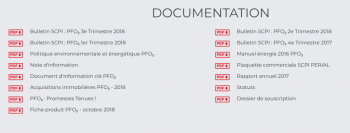Today I’m going to show you how you can invest in real estate from home…
…without ever having to meet a tenant or having to deal with all the hassle of rental management…
…without even having to spend hours analyzing properties on LeBonCoin or making visits on weekends.
All this, while guaranteeing a return much higher than that of Life Insurance.
Interested ?
In this guide, I’ll walk you through passive real estate investing step by step.
Let’s go.
If like me your time is an important resource, then you are going to want to read the following. I discovered an investment medium unknown to the French, and which nevertheless pays more than life insurance.
Everything starts from a starting point known to all: real estate. It is well known that real estate is a safe investment that allows you to have a high return without having to produce anything.
You give someone a space, and they live in it. There is nothing to make or sell. Real estate is therefore a perfect investment for all lazy investors: once your tenant moves in, everything goes automatic.
You collect the rent every month, by doing nothing .
Yet, as tempting as it sounds on paper, a live real estate investment like I just described comes with risks. In the event of a leak, damage, or even disagreement with the tenant, it will be up to you to manage the situation.
And that can get annoying, especially if your rental property is far from where you live.
The solution ? Instead of investing directly, you can place your money in a very specific form of company which has an ultra-specific goal: use investors’ money to buy buildings and rent them out.
They are called SCPIs: Civil Real Estate Investment Companies.
Every month, you receive a portion of the rents up to your investment.
And if there is a water or gas leak, you stay at home. The SCPI is responsible for all rental management. You can stay at the beach while we take care of your investment.
This investment medium therefore offers serious advantages: you give your money, and you acquire shares in a company that owns many buildings in France. Each quarter, it pays you part of the rent.
SCPIs can invest in two types of real estate :
Added to this is a second dimension: the quality of the SCPI. The vast majority of SCPIs are called yield , that is to say that they seek to maximize rents for the investor . However, there are also so-called tax SCPIs . Possessing a much lower yield (2 to 3%), their aim is to reduce investors’ income tax as much as possible by buying real estate allowing them to benefit from tax advantages. We thus have Robien SCPIs, Malraux SCPIs in reference to the tax laws that they use to reduce the taxation of investors.
To simplify, if you are looking for a strong dividend every quarter and your taxation is sustainable, then yield SCPIs are what you need. You will earn more than with life insurance, while having a stabilized tax.
Otherwise, if you want to reduce your taxation then tax SCPIs are an excellent tool. Certainly, you will not aim for the return, but your investment will allow you to reduce your taxation automatically.
Now let’s see together what an SCPI offers.
I chose a performance SCPI to start with, to give you an idea of the possible return on investment. I chose the SCPI named PFO2, managed by Périal.
The best way to discover an SCPI is to go to its website. Go!
Here, immediately we can spot two things:
Going down a little further down the page, we come across this:
This is all the financial data of the SCPI PFO2.
That’s a lot of numbers…
But if we take it slowly, one by one, you’ll see that there really aren’t many very complicated things:
We have just analyzed the PFO2 financial data and we have enough elements to determine if it is worth going further in the analysis.
PFO2 is geographically and sectorally diversified, which reduces the risk of loss of return. It has a strong retained earnings, proof of its prudent strategy aimed at guaranteeing long-term income for partners. Despite everything, his remuneration remains honorable: around 5.2%. The number of partners exceeds 13,500. The capitalization exceeds one billion euros, which makes it a large SCPI. However, PFO2 remains a young SCPI created in 2009, and there is therefore little visibility on the long-term real estate strategy of PFO2.
With these elements, the average investor should still be intrigued and want to go further. Indeed, here are some other more advanced indicators that allow you to make an investment decision on an SCPI:
To obtain these figures for PFO2, go to the Documentation section. Then click to access the SCPI PFO2 newsletters:
In order to have the most recent figures, download the latest newsletter. You then access all of the SCPI’s financial data as of December 31, 2014.
At the opening, we see a realizable value per share < purchase price of a share (182 euros). As we have just seen, this is not very good: by investing, you pay more for the real estate stock than what it is really worth!
Then, we see that the occupancy rate has been in continuous decline for 3 quarters:
So the data isn’t great.
My investment decision is as follows: given the figures, I therefore advise against investing in this SCPI.
Your property income from SCPIs can be taxed in two different ways:
Investing in SCPIs is a gateway to real estate that generates a comfortable return on investment (between 4 and 5%), well above life insurance. In addition, no rental management effort is necessary. However, this passive investment remains far from the double-digit returns found in direct real estate.
The SCPI is therefore an investment for those who do not want to take the lead but who wish to receive an honorable return on investment.






